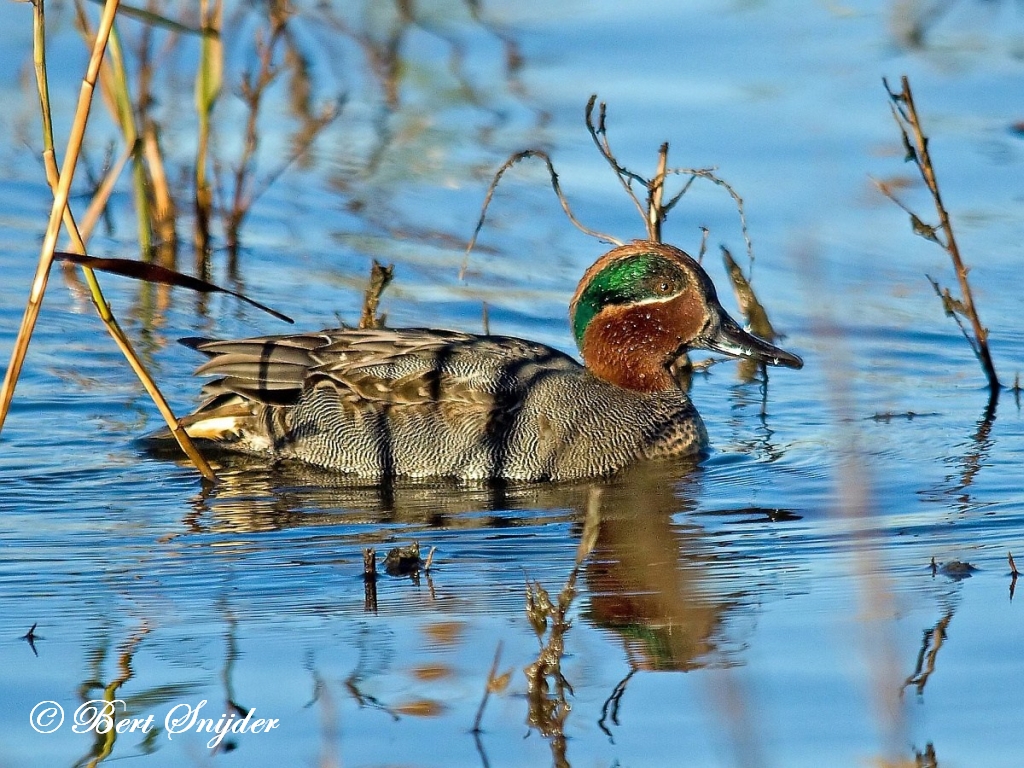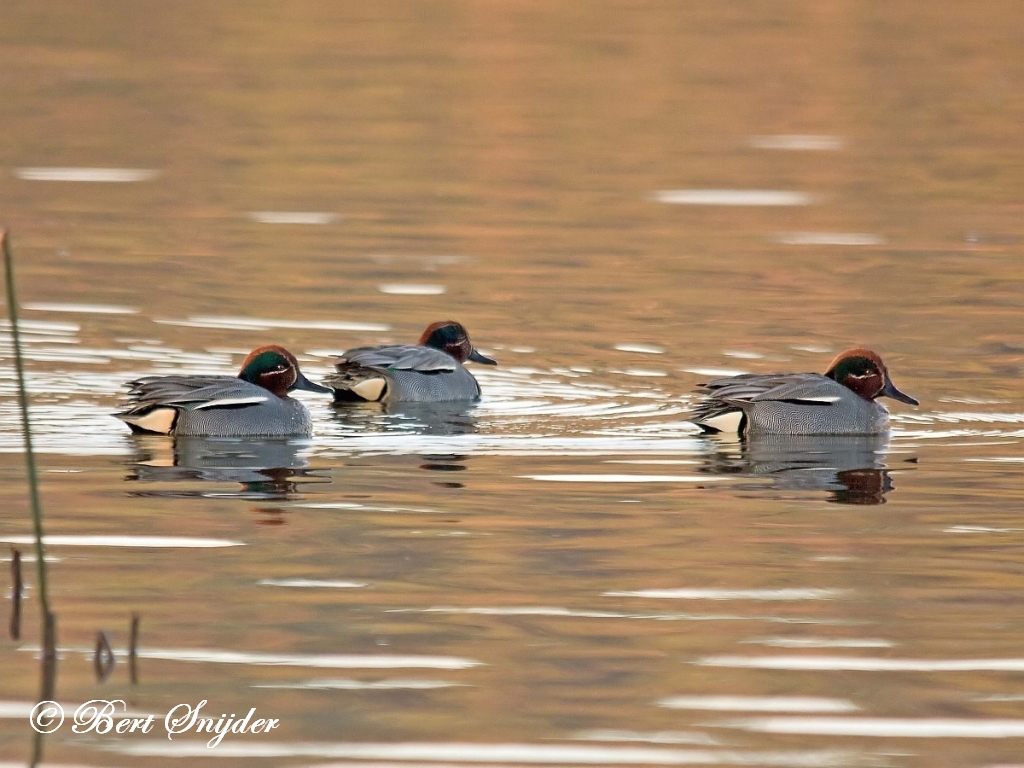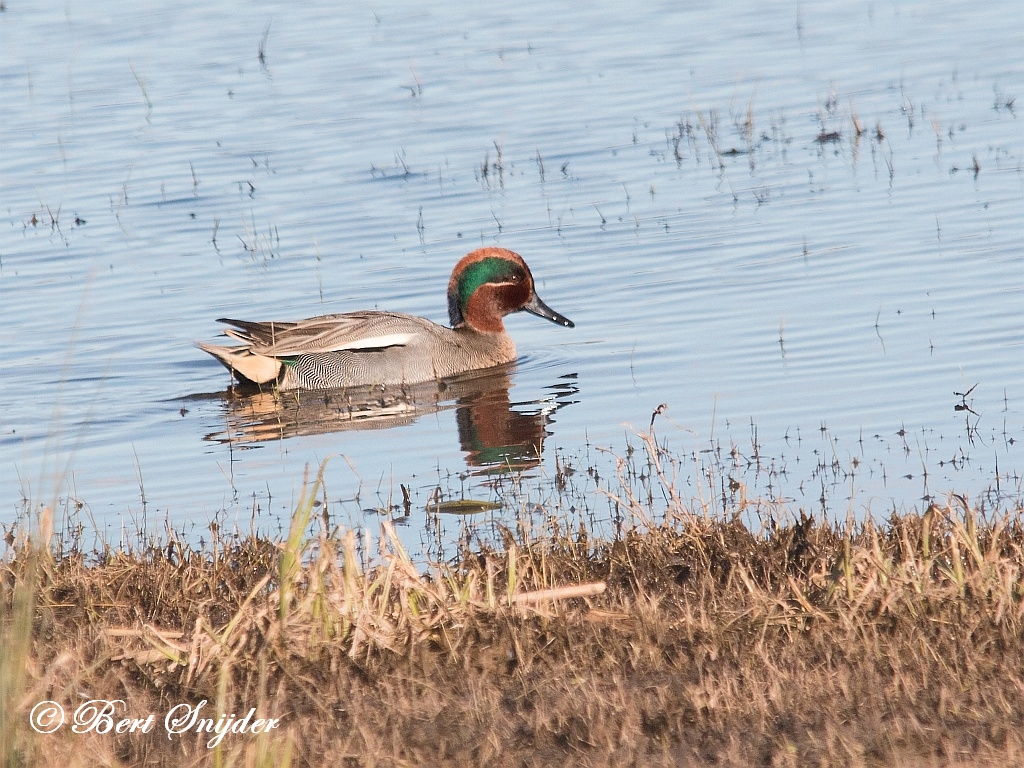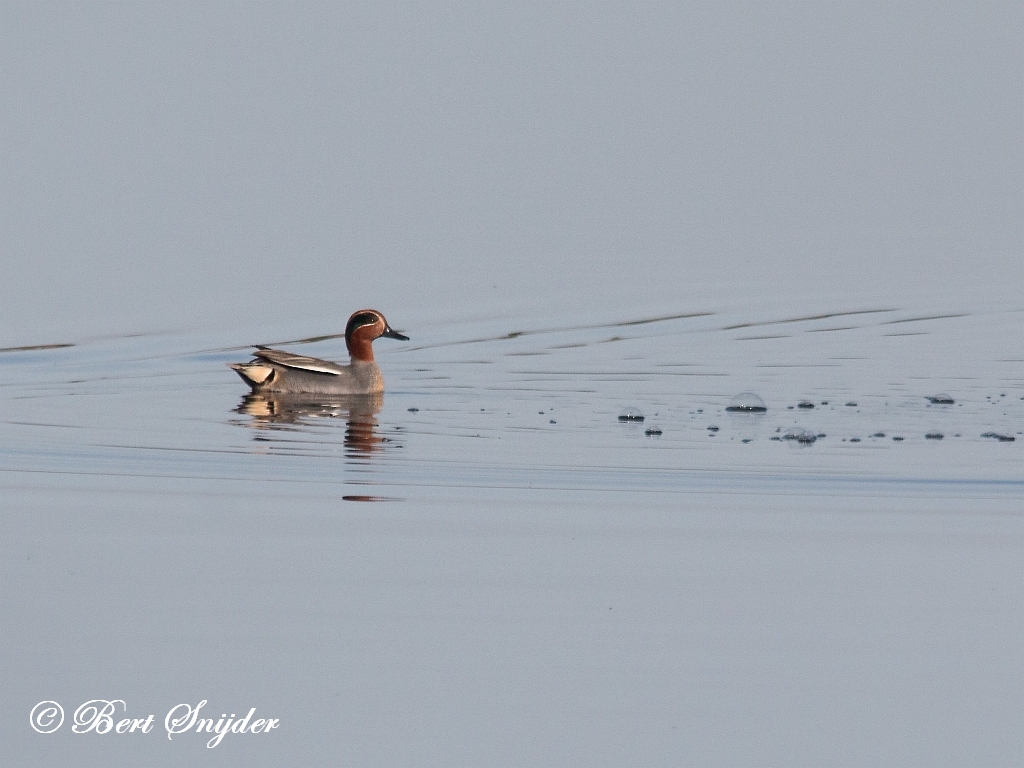Eurasian Teal, Wintertaling, Krickente, Marrequinha-comum, Cerceta común
Spotted in the Alentejo region of Portugal. Teal sound
The Eurasian Teal or Common Teal (Anas crecca) is a common and widespread duck which breeds in temperate Eurasia and migrates south in winter.

More photos at the bottom of this page.
The Eurasian Teal is often called simply the Teal due to being the only one of these small dabbling ducks in much of its range. The bird gives its name to the blue-green colour teal.
It is a highly gregarious duck outside the breeding season and can form large flocks. It is commonly found in sheltered wetlands and feeds on seeds and aquatic invertebrates. The North American Green-winged Teal (A. carolinensis) was formerly (and sometimes is still) considered a subspecies of A. crecca.
The Eurasian Teal is the smallest extant dabbling duck at 20–30 cm (13–17 in) length and with an average weight of 340 g (13 oz) in drake (males) and 320 g (12 oz) in hens (females). The wings are 17.5–20.4 cm (6.9–8.0 in) long, yielding a wingspan of 53–59 cm (21–23 in). The bill measures 3.2–4 cm (1.3–1.6 in) in length, and the tarsus 2.8–3.4 cm (1.1–1.3 in).
From a distance, the drakes in nuptial plumage appear grey, with a dark head, a yellowish behind, and a white stripe running along the flanks. Their head and upper neck is chestnut, with a wide and iridescent dark green patch of half-moon- or teardrop-shape that starts immediately before the eye and arcs to the upper hindneck. The patch is bordered with thin yellowsh-white lines, and a single line of that colour extends from the patch’s forward end, curving along the base of the bill. The breast is buff with small round brown spots. The center of the belly is white, and the rest of the body plumage is mostly white with thin and dense blackish vermiculations, appearing medium grey even at a short distance. The outer scapular feathers are white, with a black border to the outer vanes, and form the white side-stripe when the bird is in resting position. The primary remiges are dark greyish brown; the speculum feathers are iridescent blackish-green with white tips, and form the speculum together with the yellowish-white tips of the larger upperwing coverts (which are otherwise grey). The underwing is whitish, with grey remiges, dense dark spotting on the inner coverts and a dark leading edge. The tail and tail coverts are black, with a bright yellowish-buff triangular patch in the center of the coverts at each side.
In non-breeding (eclipse) plumage, the drake looks more like the hen; it is more uniform in colour, with a dark head and vestigial facial markings. The hen itself is yellowish-brown, somewhat darker on wings and back. It has a dark greyish-brown upper head, hindneck, eyestripe and feather pattern. The pattern is dense short streaks on the head and neck, and scaly spots on the rest of the body; overall they look much like a tiny Mallard (A. platyrhynchos) hen when at rest. The wings are coloured similar to the drake’s, but with brown instead of grey upperwing coverts that have less wide tips, and wider tips of the speculum feathers. The hen’s rectrices have yellowish-white tips; the midbelly is whitish with some dark streaking.
Immatures are coloured much like hens, but have a stronger pattern. The downy young are coloured like in other dabbling ducks: brown above and yellow below, with a yellow supercilium. They are recognizable by their tiny size however, weighing just 15 grams (about half an ounce) at hatching.
The drake’s bill is dark grey, in eclipse plumage often with some light greenish or brownish hue at the base. The bill of hens and immatures is pinkish or yellowish at the base, becoming dark grey towards the tip; the grey expands basewards as the birds age. The feet are dark grey in males and greyish olive or greyish-brown in females and immatures. The iris is always brown.
This is a noisy species. The male whistles cryc or creelycc, not loud but very clear and far-carrying. The female has a feeble keh or neeh quack.
Males in nuptial plumage are distinguished from Green-winged Teals by the horizontal white scapular stripe, the lack of a vertical white bar at the breast sides, and the quite conspicuous light outlines of the face patch, which are indistinct in the Green-winged Teal drake. Males in eclipse plumage, females and immatures are best recognised by their small size, calls, and the speculum; they are hard to tell apart from the Green-winged Teal.





Other synonyms:
Asturian: Zarceta Coríu, Zarceta Nanín
Azerbaijani: Fitçi cüre
Breton: Ar c’hrak-goañv, Krak-goañv, Krakhouad
Catalan: Cetla rossa, Sarset, Xarxet, Xarxet comú
Catalan (Balears): Cetla rossa
Valencian: Sarset
Czech: Círka obecná, ?írka obecná
Welsh: Corhwyaden, Corhwyaden asgell-werdd
Danish: Krikand
German: Europäische Krickente, Krickente
Emiliano-romagnolo: Pazzett
English: Common teal, Eurasian Common Teal, Eurasian green-winged teal, Eurasian Teal, European Teal, Greenland Green-winged Teal, green-winged teal, Green-winged Teal (Eurasian), Teal
Esperanto: Kreko
Spanish: Cerceta ala verde, cerceta alaverde, Cerceta Aliverde, Cerceta Comun, Cerceta común, Pato Aliverde, Yaguasa aliverde
Spanish (Colombia): Pato Aliverde
Spanish (Costa Rica): Cerceta aliverde
Spanish (Dominican Rep.): Pato de la Carolina
Spanish (Honduras): Yaguasa aliverde
Spanish (Mexico): cerceta ala verde, cerceta alaverde, Cerceta Aliverde
Spanish (Nicaragua): Cerceta Común
Estonian: Piilpart
Basque: Xarxet comú, Zertzeta arrunt, Zertzeta arrunta
Finnish: Tavi
Faroese: Krikkont, Krikk-ont, Stikkont, Stikk-ont
French: Sarcelle à ailes vertes, Sarcelle d’hiver, Sarcelle d’hiver d’Europe
Frisian: Piiptsjilling
Irish: Praslacha, praslacha ghlaseiteach, Siolta
Guadeloupean Creole French: Sarcelle
Gaelic: Crann-Lach
Galician: Cerceta, Xarxet comú
Manx: Laagh Laaghag, Laaghag
Haitian Creole French: Sasèl zèl vèt
Croatian: Kržulja, Patka kržulja
Hungarian: Csörgõ réce
Icelandic: Urtönd
Italian: Alzavola, Alzavola comune
Japanese: Ko-gamo, Ko-gamo. 075-1. Subsp. A. c. crecca. Teal. Ko-gamo, Taka-bu-gamo
Karelian: Tavi
Cornish: Cor-hos
Latin: Anas crecca, Anas crecca crecca, Anas crecca crecca/nimia, Nettion crecca, Nettion crecca crecca
Malay: Itik Teal
Maltese: Sarsella
Dutch: Wintertaling
Norwegian: Krikkand, Lortand, Pyttand
Polish: cyraneczka, cyraneczka (zwyczajna), Cyraneczka zwyczajna
Portuguese: Marrequinha, Marrequinha-comum, marrequinho, Marrequinho-comum
Romansh: Anda crecca
Scots: Crann lach
Northern Sami: Ciksa
Slovenian: kreheljc
Albanian: Rosa kere
Serbian: krkavac, kržuja, Mala krdža, Mala krdža, kržuja, krkavac, patka krža
Swedish: Kricka
Swahili: Bata Bawa-kijani
Travel Birdwatching Holiday Alentejo, Vacation Portugal for birders to see birds on your trip. Guided Birdwatching Tours & Trips.